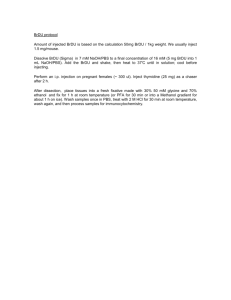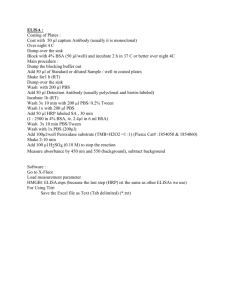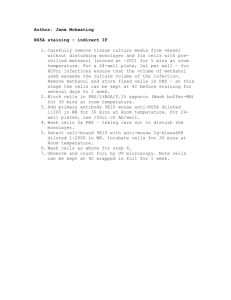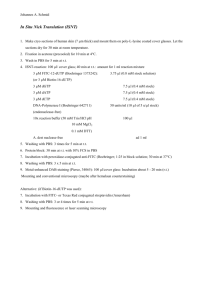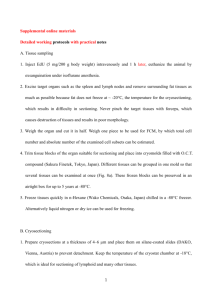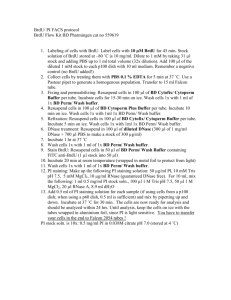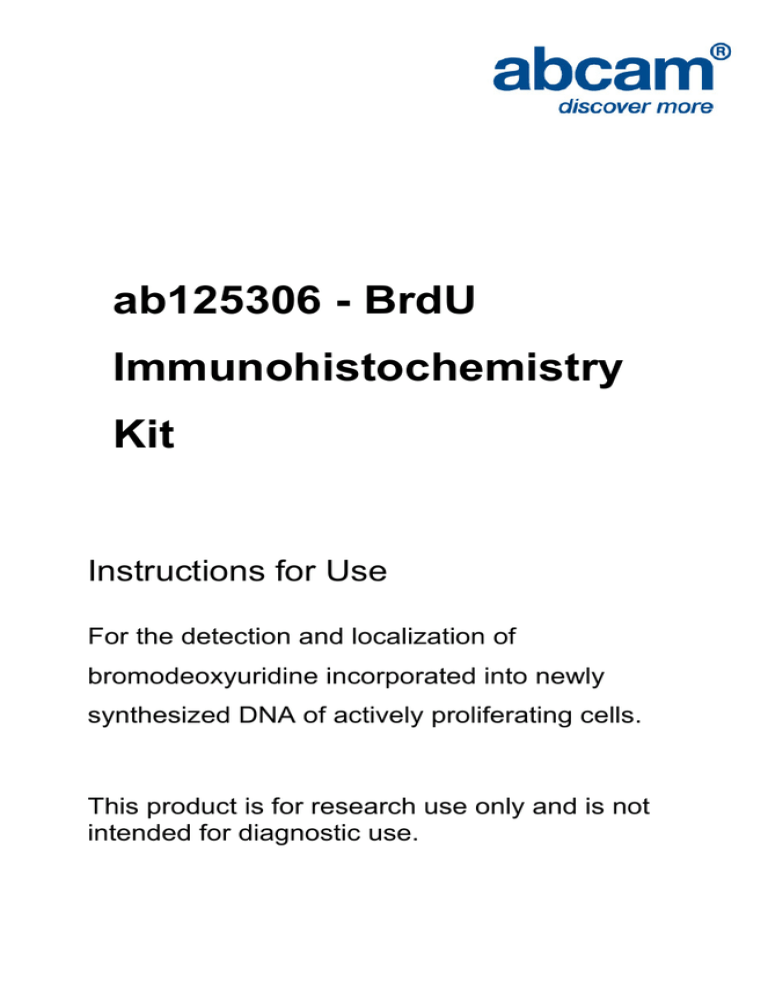
ab125306 - BrdU
Immunohistochemistry
Kit
Instructions for Use
For the detection and localization of
bromodeoxyuridine incorporated into newly
synthesized DNA of actively proliferating cells.
This product is for research use only and is not
intended for diagnostic use.
Table of Contents
1.
Introduction
2
2.
Assay Summary
3
3.
Kit Contents
5
4.
Storage and Handling
6
5.
Additional Materials Required
7
6.
Preparation of Slides
8
7.
Staining Protocol
11
8.
Sample Images
16
9.
Troubleshooting
18
1
1. Introduction
Evaluation of cell cycle progression is essential for investigations in
many scientific fields. Measurement of [3H] thymidine incorporation
as cells enter S phase has long been the traditional method for the
detection of cell proliferation. Subsequent quantification of [3H]
thymidine is performed by scintillation counting or autoradiography.
This technology is slow, labor intensive and has several limitations
including the handling and disposal of radioisotopes and the
necessity of expensive equipment.
A well-established alternative to [3H] thymidine uptake has been
demonstrated by numerous investigators. In these methods
bromodeoxyuridine (BrdU), a thymidine analog, replaces [3H]
thymidine. BrdU is incorporated into newly synthesized DNA strands
of actively proliferating cells. Following partial denaturation of double
stranded DNA, BrdU is detected immunochemically allowing the
assessment of the population of cells which are actively synthesizing
DNA.
ab125306 involves incorporation of BrdU into proliferating cells,
in vivo or in vitro, and visual staining (dark brown nuclei) of these
cells which is achieved using a biotinylated anti-BrdU antibody
followed
by
Streptavidin-HRP
Conjugate
and
DAB
(diaminobenzidine) substrate.
2
2. Assay Summary
Prepare slides
Deparaffinization (for paraffin-embedded tissues only), proceed to
next step for non-paraffin-embedded tissues.
Incubation with Quenching Solution followed by PBS wash step.
Incubation with Trypsin Enzyme Concentrate and Dilution Buffer
followed by a rinse with distilled water.
Incubation with Denaturing Solution followed by PBS wash step.
Incubation with Blocking Solution.
Incubation with Detector Antibody followed by PBS wash step.
Incubation with Streptavidin-HRP Conjugate followed by PBS wash
step.
3
Incubation with Substrate Reaction Buffer and DAB Concentrate
followed by distilled water wash step.
Incubation with Hematoxylin Counterstain followed by water and
PBS wash steps.
Incubation with ethanol followed by xylene.
Add mounting media and coverslip.
4
3. Kit Contents
The material in this kit is sufficient to run 50 slides. The average test
area is defined as a circle around the tissue with an approximate
diameter of 2 centimeters.
Item
Quantity
4X Trypsin Enzyme Concentrate*
3 mL
Trypsin Dilution Buffer*
12 mL
Denaturing Solution
6 mL
Blocking Buffer
6 mL
Detector Antibody (Biotinylated and pre-diluted)
6 mL
Streptavidin-HRP Conjugate (pre-diluted)
6 mL
Substrate Reaction Buffer
6 mL
DAB Concentrate
0.3 mL
Hematoxylin Counterstain
6 mL
Mounting Media
6 mL
Control Slides**
5
5
* Trypsin is only required if using formalin fixed tissues. If the tissues
are fixed in alcohol, trypsin digestion is not required.
**Intestinal tissue from mouse pulsed with BrdU.
4. Storage and Handling
Upon receipt, store entire kit at -20°C. Once the kit is thawed, user
may keep the kit at 4°C for 5 days. For long-term storage, it is
recommended user aliquot and freeze the components at -20°C,
particularly the Streptavidin-HRP Conjugate, the Detector Antibody
and the Trypsin Concentrate.
6
5. Additional Materials Required
Quenching Solution: Hydrogen peroxide (30% solution) for
quenching endogenous peroxidase activity.
Phosphate buffered saline (PBS) solution
Distilled water
Ethyl alcohol
Xylene
Coverslips
Bromodeoxyuridine (BrdU)
Methanol
7
6. Preparation of Slides
Paraffin-Emmbedded tissue sections:
1. Sample animals are labeled with BrdU
2. Animals are sacrificed by inhalation of isofluorane and
perfused with PBS followed by 4% buffered formalin.
3. Target tissue is removed and immersed in 4% buffered
formalin overnight.
4. Tissue is then dehydrated and embedded in paraffin
a. PBS — 10 min
b.
70% EtOH — 1 hour
c.
85% EtOH — 1 hour
d. 95% EtOH — 30 min
e. 100% EtOH — 15min (2X)
f.
Xylene — 15 min (2X)
g. 1:1 Xylene and Paraffin — 45 min
h. Paraffin — 30 min (4X)
5. Five micron sections are cut from the paraffin blocks and
placed on slides.
8
6. Slides remain on a 37°C heating tray overnight and are
then stored at 4°C.
Cultured Cells and Cell Suspensions – Preparation of Cells:
A. Cells in Flasks
1. Using sterile tissue culture techniques, culture
cells with 10µM BrdU for 2 - 24 hours at 37ºC.
2. Remove the media containing the BrdU label
and wash twice with PBS.
3. Using a cytospin, centrifuge 100µl of cells at 1 x
106 cells/ml onto suitable slides and allow to air
dry.
4. Proceed with Staining Protocol.
9
B. Cells on Chamber Slides (Adherent cells only)
1. Using sterile tissue culture techniques, culture
cells in chambers with 10μM BrdU for 2 - 24
hours at 37ºC.
2. Remove the labelling media and wash twice with
PBS.
3. Fix cells with 70% ethanol or other suitable
fixative for 30 minutes.
4. Wash twice with PBS.
5. Proceed with Staining Protocol.
10
7. Staining Protocol
1. Deparaffinization (For paraffin-embedded tissues only)
Note: If you are not using paraffin-embedded tissues,
skip to step 2 below. If paraffin-embedded tissues are
used, it is necessary to deparaffinize the slides before
following the BrdU staining protocol below.
Deparaffinization involves incubation of the slides in xylene
followed by a graded alcohol series as follows:
Step
Substance
Incubation Time
1.1
Xylene
5 minutes, then change to new
coplin jar containing Xylene.
1.2
Xylene
5 minutes
1.3
100% ethyl
alcohol
5 minutes
1.4
90% ethyl alcohol
3 minutes
1.5
80% ethyl alcohol
3 minutes
1.6
70% ethyl alcohol
3 minutes
1.7
PBS
3 minutes
11
2. Staining
Step
Component
Component
Preparation
Procedure
Time
(Min)
2.1
Hydrogen
peroxide
(30%
solution)
Quenching
Solution (not
provided).
Dilute 30%
hydrogen
peroxide* 1:10
in methanol.
Immerse slides into
a coplin jar or other
appropriate
container filled with
quenching solution
for 10 minutes.
Wash with PBS 1x
for 2 minutes.
10
2.2
4X Trypsin
Enzyme
Concentrate
and Trypsin
Dilution Buffer
Trypsin (0.2%
solution)**
FOR
FORMALIN
FIXED
TISSUES
ONLY.
Add 1 drop of
4X Trypsin
Enzyme
Concentrate to
3 drops of
Trypsin
Dilution Buffer
and mix well.
Add 2 or more
drops to each slide.
Incubate at room
temperature for 10
mins followed by a
3 min rinse in
distilled water.
10
12
2.3
Denaturing
Solution
N/A
2.3
Blocking
Buffer
N/A
2.4
Detector
Antibody
N/A
2.5
StreptavidinHRP
Conjugate
N/A
Add 2 or more
drops to each slide
and incubate at
room temperature
for 30 mins. Wash
twice with PBS, 2
mins per wash.
Add 2 or more
drops to each slide
and incubate at
room temperature
for 10 mins. Drain
the solution by
blotting on paper
towels (DO NOT
RINSE)
Add 2 or more
drops to each slide
and incubate at
room temperature
for 60 mins. Wash
twice with PBS, 2
mins per wash.
Add 2 or more
drops to each slide
and incubate at
room temperature
for 10 mins. Wash
twice with PBS, 2
mins per wash.
30
10
60
10
13
2.6
Substrate
Reaction
Buffer and
DAB
concentrate
N/A
2.7
Hematoxylin
Counterstain
N/A
Add 1 µL DAB
concentrate for
every 29 µL
Substrate Reaction
Buffer (assume
approximately 100
µL/slide). For 10
slides, this works
out to be 1 drop of
DAB concentrate to
1 mL of Substrate
Reaction Buffer.
Mix well and add 2
or more drops per
slide and incubate
at room
temperature for 10
mins. Wash with
distilled water for 2
mins.
Add 2 or more
drops of
hematoxylin per
slide and incubate
at room
temperature for 1-5
mins. Wash slides
briefly with tap
water. Incubate
slides for 1 min in
PBS until color
turns blue. Give a
final 2-min wash in
distilled water.
10
1-5
14
2.8
Mounting
Media
N/A
Incubate slides in
90% ethanol for 30
seconds, 100%
ethanol for 30
Seconds and
xylene for 30
seconds (2 times
each). Add 1-2
drops of mounting
media and
coverslip.
* Hydrogen peroxide is not stable for long periods of time.
Be sure the reagent you are using has not expired.
** The concentration of trypsin used is very important. It may
be necessary to titer the trypsin reagent for use in your
system. Usually a final concentration of 0.02% to 0.2% is
appropriate. Other methods for digesting the tissue to
expose epitopes for antibody recognition may also be used.
15
8. Sample Images
Example images of formalin-fixed, paraffin embedded mouse
intestinal tissue sections stained using ab125306.
16
17
9. Troubleshooting
1. Poor Positive Staining or No Positive Staining with Little
or No Background Staining
Little or no BrdU labeling occurred in the tissue or cells
prior to preparing the slides.
Detector antibody or Streptavidin-HRP reagent was
omitted or used in the wrong order.
Use a longer incubation times for Detector Antibody.
Use a longer incubation time for substrate (view slide
while it is developing).
Since
positive
excessive
brown
counterstaining
DAB
staining,
can
try
compromise
using
shorter
hematoxylin counterstain incubation time.
DO NOT LET SLIDES DRY OUT; keep wet at all times
during the staining procedure.
Insufficient blotting between blocking step and detector
antibody step. This could dilute out the Detector
Antibody component.
If tissue is formalin fixed and digestion of the tissue is
necessary, the trypsin component may need titering.
18
Use fresh xylene solution as solution which has been
used many times will contain residual paraffin and may
interfere with staining.
2. High Background Staining
Reduce substrate incubation time.
Check to make sure the substrate-DAB reagent was
prepared correctly (the right ratio of DAB concentrate to
Substrate Reaction Buffer).
Reduce
concentration
of
the
Streptavidin-HRP
Component.
Increase the number and time of washes in between
steps.
Slides incorrectly deparaffinized (use fresh reagents,
xylene and ethanol for the de-paraffinization procedure).
19
20
21
22
UK, EU and ROW
Email:
technical@abcam.com
Tel: +44 (0)1223 696000
www.abcam.com
US, Canada and Latin America
Email: us.technical@abcam.com
Tel: 888-77-ABCAM (22226)
www.abcam.com
China and Asia Pacific
Email: hk.technical@abcam.com
Tel: 108008523689 (中國聯通)
www.abcam.cn
Japan
Email: technical@abcam.co.jp
Tel: +81-(0)3-6231-0940
www.abcam.co.jp
Copyright © 2012 Abcam, All Rights Reserved. The Abcam logo is a registered trademark.
All information / detail is correct at time of going to print.
23

